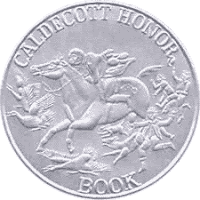
The Newbery Medal was named after English bookseller John Newbery (1713 - 1767), who published juvenile books. It is awarded annually by the Association for Library Service to Children, a division of the American Library Association, to the most distinguished contribution to American literature for children (usually written for the pre-teen audience) published in English in the United States during the preceding year. There are several criteria that must be met for a book to earn this distinguished award: 1) the book must be published in English in the United States during the previous year; 2) the author has to be a U.S. citizen; 3) the book must relate to a child audience; 4) the book has merit for its theme, presentation, plot, characters, setting, and style; 5) the book must contribute to literature; and 6) the book must be able to stand alone and  not be part of a multimedia presentation (http://www.wikipedia.org/, 2010). The Newbery Medal has been awarded since 1922.
not be part of a multimedia presentation (http://www.wikipedia.org/, 2010). The Newbery Medal has been awarded since 1922.
In 1971 the Newbery Honor Award was established, which is basically granted to "runners-up" for the Newbery Medal. According to http://www.wikipedia.org/, Laura Ingalls Wilder is the author who has received the most Newbery Honors (5); interestingly, she has never been awarded the Newbery Medal. In addition, there are only five authors who have received multiple Newbery Medals: E.L. Konigsburg, Joseph Krumgold, Lois Lowry, Katherine Paterson, and Elizabeth George Speare.
 not be part of a multimedia presentation (http://www.wikipedia.org/, 2010). The Newbery Medal has been awarded since 1922.
not be part of a multimedia presentation (http://www.wikipedia.org/, 2010). The Newbery Medal has been awarded since 1922.In 1971 the Newbery Honor Award was established, which is basically granted to "runners-up" for the Newbery Medal. According to http://www.wikipedia.org/, Laura Ingalls Wilder is the author who has received the most Newbery Honors (5); interestingly, she has never been awarded the Newbery Medal. In addition, there are only five authors who have received multiple Newbery Medals: E.L. Konigsburg, Joseph Krumgold, Lois Lowry, Katherine Paterson, and Elizabeth George Speare.

The Caldecott Medal is also a distinguished annual award given by the Association for Library Service to Children (ALA). Named after well-known English illustrator Randolph Caldecott (1846 - 1886), this award is given "to the artist of the most distinguished American picture book for children published in English in the United States during the preceding year." This award has been granted since 1938. Books are considered for this award based upon these criteria: 1) artistic technique employed; 2) pictorial interpretation of the story; 3) appropriateness of style of illustration to the story; 4) delineation of plot, theme, characters, setting mood or information through the pictures; and 5) recognition of a child audience (www.newberyawardbooks.com/general/newbery-award-vs-caldecott-medal/01/17/2010).
 Just as the runners-up of the Newbery Awards receive the Newbery Honors, the Caldecott runners-up receive the Caldecott Honor Award. There are usually several honor books each year in addition to the medal winner.
Just as the runners-up of the Newbery Awards receive the Newbery Honors, the Caldecott runners-up receive the Caldecott Honor Award. There are usually several honor books each year in addition to the medal winner.Basically, there are two main differences in the awards. The main distinction is Newbery Awards are given based on the book's story, while the Caldecott Awards are issued for a book's illustrations. Secondly, Newbery books are typically geared towards pre-teen readers and Caldecotts usually aim for younger children. Both awards are considered the most distinguished awards given in children's literature, thus you can't really say one is better than the other. Personal interest may direct individuals. For example, I am most interested in Newbery winners, because I look at a book for its plot. Many people love children's books for their illustrations. While I do love to look at beautiful pictures when I'm reading, that is not what I focus on when I pick up a book. I want my imagination to paint my own pictures as I become engrossed in the story. But reading a book to children and watching their faces as they listen and "see" the story through the illustrations is also a priceless moment. I do agree books should be recognized for their stories as well as for their illustrations, so Newbery and Caldecott Awards seem to be the best invention for recognizing these two aspects of children's books.


No comments:
Post a Comment